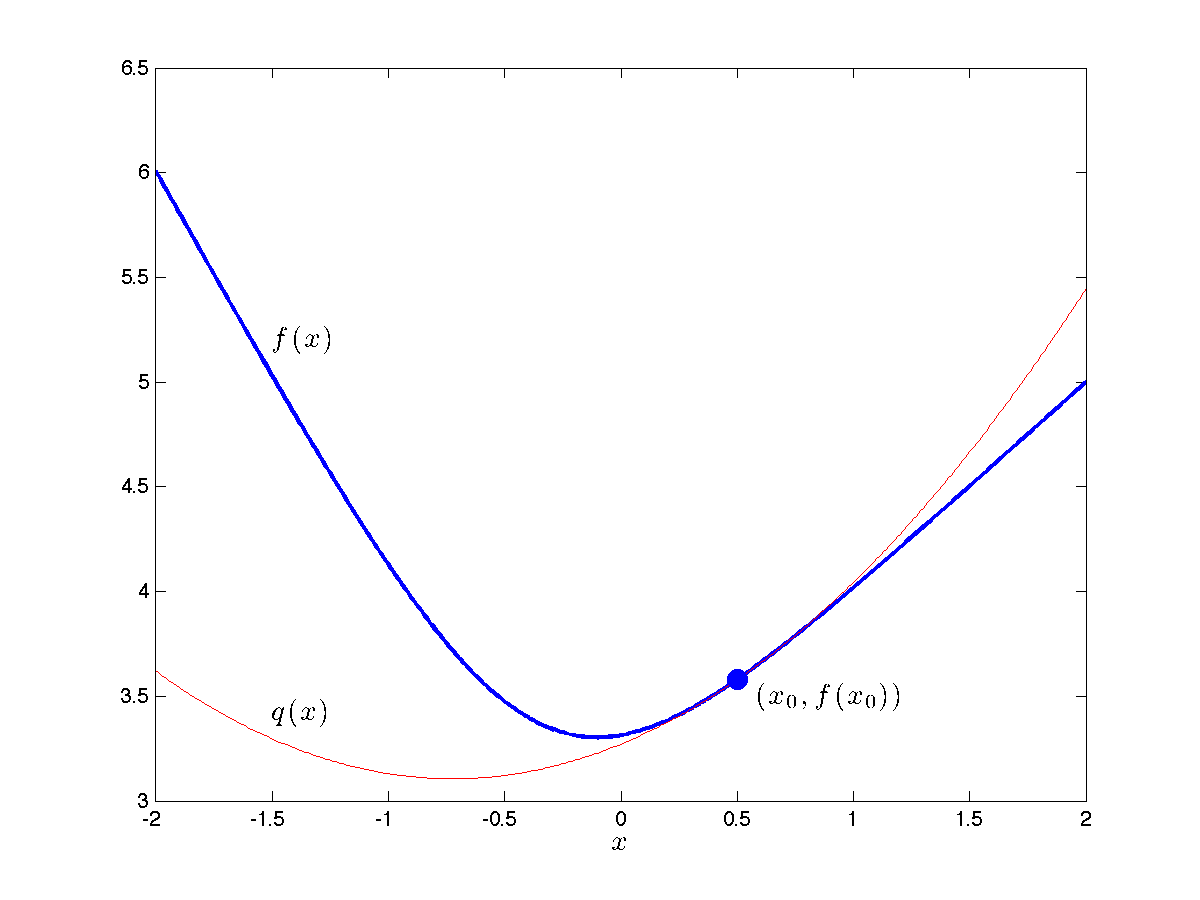Definitions
- Symmetric matrices and quadratic functions
- Second-order approximation of non-linear functions
- Special symmetric matrices
Symmetric matrices and quadratic functions
Symmetric matrices
A square matrix ![]() is symmetric if it is equal to its transpose. That is,
is symmetric if it is equal to its transpose. That is,
The set of symmetric ![]() matrices is denoted
matrices is denoted ![]() . This set is a subspace of
. This set is a subspace of ![]() .
.
Examples:
- A
 example.
example. - Representation of a weighted, undirected graph.
- Laplacian matrix of a graph.
- Hessian of a function.
- Gram matrix of data points.
Quadratic functions
A function ![]() is said to be a quadratic function if it can be expressed as
is said to be a quadratic function if it can be expressed as
for numbers ![]() ,
, ![]() , and
, and ![]() ,
, ![]() . A quadratic function is thus an affine combination of the
. A quadratic function is thus an affine combination of the ![]() ‘s and all the ‘‘cross-products’’
‘s and all the ‘‘cross-products’’ ![]() . We observe that the coefficient of
. We observe that the coefficient of ![]() is
is ![]() .
.
The function is said to be a quadratic form if there are no linear or constant terms in it: ![]() ,
, ![]() .
.
Note that the Hessian (matrix of second-derivatives) of a quadratic function is constant.
Examples:
Link between quadratic functions and symmetric matrices
There is a natural relationship between symmetric matrices and quadratic functions. Indeed, any quadratic function ![]() can be written as
can be written as
for an appropriate symmetric matrix ![]() , vector
, vector ![]() and scalar
and scalar ![]() . Here,
. Here, ![]() is the coefficient of
is the coefficient of ![]() in
in ![]() ; for
; for ![]() ,
, ![]() is the coefficient of the term
is the coefficient of the term ![]() in
in ![]() ;
; ![]() is that of
is that of ![]() ; and
; and ![]() is the constant term,
is the constant term, ![]() . If
. If ![]() is a quadratic form, then
is a quadratic form, then ![]() ,
, ![]() , and we can write
, and we can write ![]() where now
where now ![]() .
.
Examples:
Second-order approximations of non-quadratic functions
We have seen how linear functions arise when one seeks a simple, linear approximation to a more complicated non-linear function. Likewise, quadratic functions arise naturally when one seeks to approximate a given non-quadratic function by a quadratic one.
One-dimensional case
If ![]() is a twice-differentiable function of a single variable, then the second-order approximation (or, second-order Taylor expansion) of
is a twice-differentiable function of a single variable, then the second-order approximation (or, second-order Taylor expansion) of ![]() at a point
at a point ![]() is of the form
is of the form
where ![]() is the first derivative, and
is the first derivative, and ![]() the second derivative, of
the second derivative, of ![]() at
at ![]() . We observe that the quadratic approximation
. We observe that the quadratic approximation ![]() has the same value, derivative, and second-derivative as
has the same value, derivative, and second-derivative as ![]() , at
, at ![]() .
.
 |
Example: The figure shows a second-order approximation at the point |
Multi-dimensional case
In multiple dimensions, we have a similar result. Let us approximate a twice-differentiable function ![]() by a quadratic function
by a quadratic function ![]() , so that
, so that ![]() and
and ![]() coincide up and including to the second derivatives.
coincide up and including to the second derivatives.
The function ![]() must be of the form
must be of the form
where ![]() ,
, ![]() , and
, and ![]() . Our condition that
. Our condition that ![]() coincides with
coincides with ![]() up and including to the second derivatives shows that we must have
up and including to the second derivatives shows that we must have
where ![]() is the Hessian, and
is the Hessian, and ![]() the gradient, of
the gradient, of ![]() at
at ![]() .
.
Solving for ![]() we obtain the following result:
we obtain the following result:
Second-order expansion of a function. The second-order approximation of a twice-differentiable function ![]() at a point
at a point ![]() is of the form
is of the form
where ![]() is the gradient of
is the gradient of ![]() at
at ![]() , and the symmetric matrix
, and the symmetric matrix ![]() is the Hessian of
is the Hessian of ![]() at
at ![]() .
.
Example: Second-order expansion of the log-sum-exp function.
Special symmetric matrices
Diagonal matrices
Perhaps the simplest special case of symmetric matrices is the class of diagonal matrices, which are non-zero only on their diagonal.
If ![]() , we denote by
, we denote by ![]() , or
, or ![]() for short, the
for short, the ![]() (symmetric) diagonal matrix with
(symmetric) diagonal matrix with ![]() on its diagonal. Diagonal matrices correspond to quadratic functions of the form
on its diagonal. Diagonal matrices correspond to quadratic functions of the form
Such functions do not have any ‘‘cross-terms’’ of the form ![]() with
with ![]() .
.
Example: A diagonal matrix and its associated quadratic form.
Symmetric dyads
Another important class of symmetric matrices is that of the form ![]() , where
, where ![]() . The matrix has elements
. The matrix has elements ![]() and is symmetric. Such matrices are called symmetric dyads. (If
and is symmetric. Such matrices are called symmetric dyads. (If ![]() , then the dyad is said to be normalized.)
, then the dyad is said to be normalized.)
Symmetric dyads correspond to quadratic functions that are simply squared linear forms: ![]() .
.
Example: A squared linear form.
